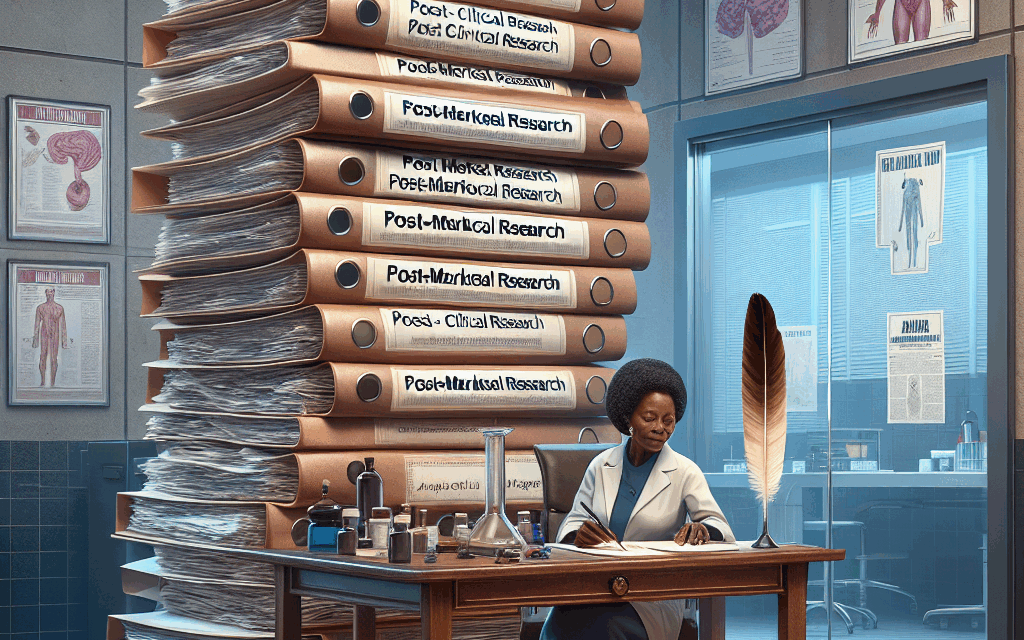Post-Market Clinical Research: Essential Insights Beyond Approval
Post-market clinical research (PMCR) plays a crucial role in the lifecycle of medical products, including drugs, devices, and biologics. While pre-market studies focus on safety and efficacy before a product reaches the market, PMCR provides essential insights into the long-term effects, real-world effectiveness, and safety of these products once they are in widespread use. This article delves into the significance of PMCR, exploring its methodologies, regulatory frameworks, challenges, and the impact it has on patient safety and healthcare practices.
Understanding Post-Market Clinical Research
Post-market clinical research refers to studies conducted after a medical product has received regulatory approval and is available to the public. The primary aim of PMCR is to gather additional data on the product’s performance in real-world settings, which can differ significantly from controlled clinical trial environments.
PMCR encompasses various types of studies, including:
- Phase IV clinical trials
- Post-marketing surveillance studies
- Registry studies
- Observational studies
- Patient-reported outcomes research
These studies are essential for identifying rare adverse events, understanding long-term effects, and assessing the product’s effectiveness across diverse populations. They also help inform clinical guidelines and regulatory decisions, ensuring that healthcare providers and patients have access to the most current information regarding the products they use.
The Importance of Post-Market Surveillance
Post-market surveillance (PMS) is a critical component of PMCR, focusing on the ongoing monitoring of medical products after they have been approved for public use. PMS aims to identify any safety issues that may arise once a product is widely used, which may not have been evident during pre-market trials.
Key aspects of post-market surveillance include:
- Monitoring adverse events and side effects
- Assessing long-term safety and effectiveness
- Identifying potential drug interactions
- Evaluating the impact of demographic factors on product performance
- Ensuring compliance with regulatory requirements
One notable example of the importance of PMS is the case of the pain reliever Vioxx (rofecoxib). Initially approved in 1999, Vioxx was later withdrawn from the market in 2004 after post-marketing studies revealed a significant increase in the risk of cardiovascular events among users. This case underscores the necessity of ongoing monitoring and the potential consequences of failing to identify safety issues in a timely manner.
Regulatory agencies, such as the U.S. Food and Drug Administration (FDA) and the European Medicines Agency (EMA), have established frameworks for PMS, requiring manufacturers to report adverse events and conduct periodic safety updates. These regulations are designed to protect public health and ensure that any emerging safety concerns are addressed promptly.
Methodologies in Post-Market Clinical Research
Post-market clinical research employs various methodologies to gather data on medical products. These methodologies can be broadly categorized into observational studies, randomized controlled trials, and registries.
Observational Studies
Observational studies are a common approach in PMCR, allowing researchers to collect data on patients using a product in real-world settings without manipulating treatment assignments. These studies can be prospective or retrospective and often involve large patient populations, making them valuable for identifying rare adverse events and long-term outcomes.
For example, the FDA’s Sentinel Initiative is a national electronic system that monitors the safety of medical products by analyzing data from various healthcare databases. This initiative allows for rapid assessment of safety signals and has been instrumental in identifying issues related to vaccines, drugs, and devices.
Randomized Controlled Trials (RCTs)
While RCTs are typically associated with pre-market studies, they can also be conducted post-marketing to evaluate specific questions about a product’s safety or effectiveness. These trials may focus on particular populations or conditions that were not adequately represented in pre-market studies.
An example of a post-marketing RCT is the study of the anticoagulant dabigatran (Pradaxa), which was conducted to assess its safety in patients with atrial fibrillation. The trial provided valuable insights into the drug’s risk of bleeding compared to warfarin, leading to updated clinical guidelines and improved patient management strategies.
Registries
Registries are another essential tool in PMCR, collecting data on patients who receive a specific treatment or intervention. These databases can provide insights into long-term outcomes, patient demographics, and treatment patterns.
The American Joint Replacement Registry (AJRR) is an example of a successful registry that tracks outcomes of hip and knee arthroplasties. By analyzing data from thousands of procedures, the AJRR has identified trends in complications and has contributed to improving surgical techniques and patient care.
Challenges in Post-Market Clinical Research
Despite its importance, post-market clinical research faces several challenges that can hinder its effectiveness. These challenges include data quality, patient recruitment, regulatory hurdles, and funding limitations.
Data Quality
One of the primary challenges in PMCR is ensuring the quality and reliability of data collected. Observational studies often rely on electronic health records (EHRs) and claims data, which can be incomplete or inaccurate. This can lead to biased results and limit the generalizability of findings.
To address these issues, researchers must implement rigorous data validation processes and consider using multiple data sources to triangulate findings. Additionally, standardizing data collection methods can enhance the reliability of results across different studies.
Patient Recruitment
Recruiting participants for post-marketing studies can be challenging, particularly for studies requiring long-term follow-up. Patients may be less motivated to participate in research once they have received their treatment, leading to lower enrollment rates.
To improve recruitment, researchers can employ strategies such as:
- Engaging patients through educational materials
- Offering incentives for participation
- Utilizing social media and online platforms to reach potential participants
- Collaborating with healthcare providers to identify eligible patients
Regulatory Hurdles
Navigating the regulatory landscape can also pose challenges for post-market clinical research. Regulatory agencies may have specific requirements for reporting adverse events and conducting studies, which can vary by region and product type.
Researchers must stay informed about these regulations and ensure compliance to avoid delays in study initiation or data reporting. Engaging with regulatory agencies early in the research process can help clarify expectations and streamline the approval process.
Funding Limitations
Funding is another significant challenge in PMCR, as many post-marketing studies are not required by regulatory agencies and may not receive financial support from manufacturers. This can limit the scope and scale of research efforts.
To overcome funding limitations, researchers can explore partnerships with academic institutions, government agencies, and non-profit organizations. Additionally, leveraging real-world data from existing databases can reduce costs and enhance the feasibility of studies.
The Impact of Post-Market Clinical Research on Patient Safety and Healthcare Practices
Post-market clinical research has a profound impact on patient safety and healthcare practices. By providing ongoing insights into the safety and effectiveness of medical products, PMCR helps inform clinical decision-making and improve patient outcomes.
Enhancing Patient Safety
One of the primary goals of PMCR is to enhance patient safety by identifying potential risks associated with medical products. By monitoring adverse events and conducting studies to assess long-term effects, researchers can provide valuable information to healthcare providers and patients.
For instance, the identification of the risk of severe skin reactions associated with the anticonvulsant drug lamotrigine led to updated prescribing information and increased awareness among healthcare providers. This proactive approach to safety can help prevent adverse events and improve patient care.
Informed Clinical Decision-Making
PMCR also plays a critical role in informing clinical decision-making. By providing real-world evidence on the effectiveness of treatments, healthcare providers can make more informed choices about patient care.
For example, the results of post-marketing studies on the cholesterol-lowering drug statins have led to updated guidelines on their use in primary prevention. This evidence-based approach ensures that patients receive the most appropriate and effective treatments based on their individual risk factors.
Shaping Regulatory Policies
The findings from PMCR can influence regulatory policies and practices, leading to more robust safety monitoring and improved product labeling. Regulatory agencies often rely on post-marketing data to assess the need for additional warnings, contraindications, or even product withdrawals.
The case of the diabetes medication rosiglitazone (Avandia) illustrates this point. Following post-marketing studies that revealed an increased risk of cardiovascular events, the FDA imposed restrictions on its use, demonstrating how PMCR can shape regulatory actions to protect public health.
Improving Healthcare Practices
Finally, PMCR contributes to improving healthcare practices by identifying best practices and treatment patterns. By analyzing data from diverse patient populations, researchers can uncover variations in care and develop strategies to enhance quality and outcomes.
The implementation of the Choosing Wisely campaign, which encourages healthcare providers to engage patients in conversations about unnecessary tests and procedures, is an example of how PMCR findings can lead to more efficient and effective healthcare delivery.
Conclusion
Post-market clinical research is an essential component of the medical product lifecycle, providing critical insights into the safety and effectiveness of treatments once they are in widespread use. By employing various methodologies, including observational studies, randomized controlled trials, and registries, PMCR helps identify potential risks, informs clinical decision-making, and shapes regulatory policies.
Despite the challenges associated with PMCR, such as data quality, patient recruitment, regulatory hurdles, and funding limitations, its impact on patient safety and healthcare practices cannot be overstated. As the healthcare landscape continues to evolve, the importance of post-market clinical research will only grow, ensuring that patients receive safe and effective treatments based on the most current evidence.
In summary, PMCR is not just a regulatory requirement; it is a vital process that enhances patient safety, informs clinical practice, and ultimately improves health outcomes. As stakeholders in the healthcare system, including researchers, regulators, and healthcare providers, continue to prioritize post-market research, we can expect to see ongoing advancements in patient care and safety.





